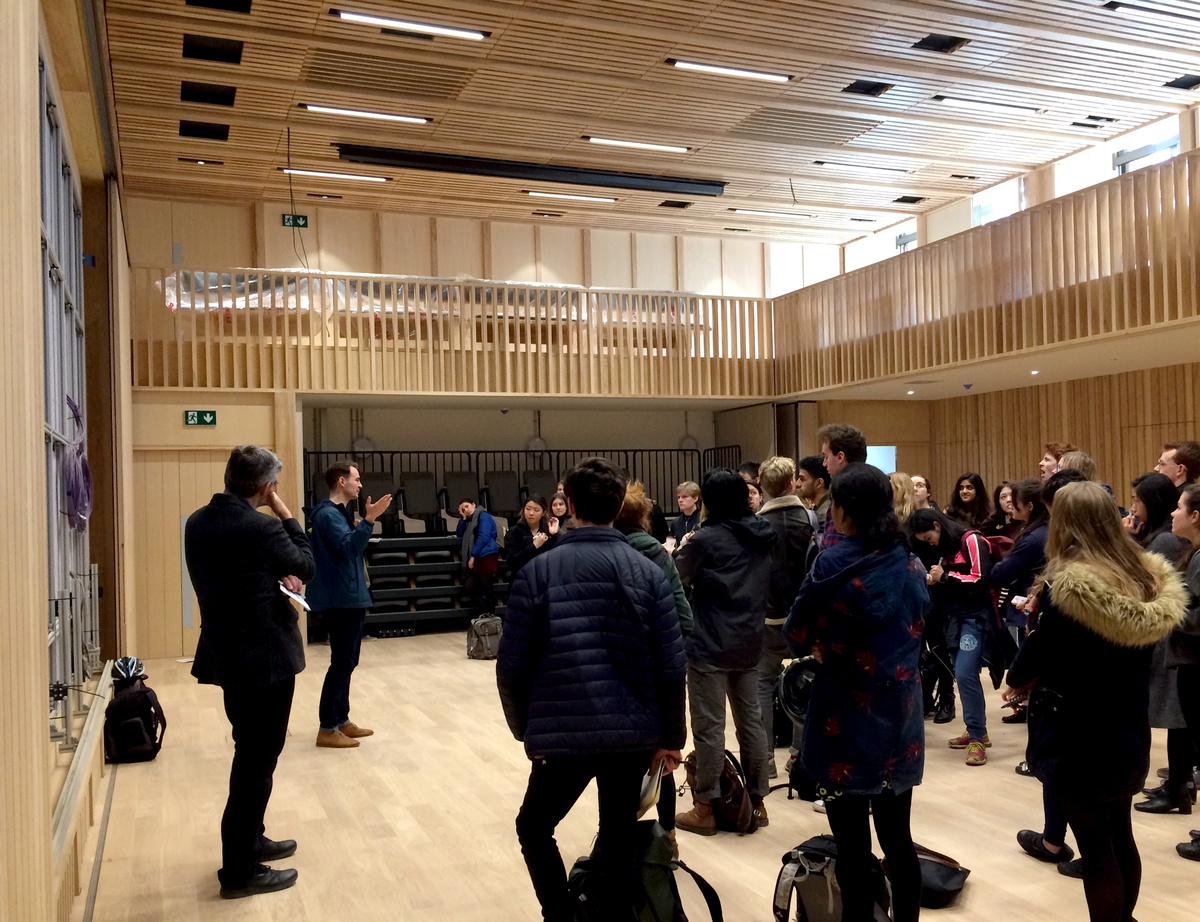CAMBRIDGE ARCHITECTURE STUDENTS TOUR OF JESUS COLLEGE
MARCH 2017

On Wednesday 1st March the University of Cambridge Year 2 architecture students visited our West Court development at Jesus College. They were invited by Professor of Sustainable Design Koen Steemers, a Fellow and Director of Studies at Jesus College. I gave a general introduction to the project in the recently completed auditorium and was asked to cover some more specific acoustic design issues to tie in with Professor Steemers’s recent lectures on acoustics.
It was great to experience the ash-lined auditorium space occupied. With the secondary glazing installed earlier in the week, there was no disturbance from noisy Jesus Lane outside and even the buzz of the busy building site beyond the four walls of the auditorium was not noticeable.
I really enjoyed the Q&A session and was surprised at the insightful questioning and level of engagement that the Year 2 students demonstrated. There were specific questions about acoustic design – Were different room shapes considered? – and more general questions about the architecture – What informed the architectural language of the Auditorium? How was the 100-year lifespan of the building considered in the selection of materials?
Having finished in the auditorium, we crossed the courtyard to the new café pavilion and ended the tour in the basement bar below. Here the acoustics are very different with glazed tiling to the walls and brass surfaces. It was interesting to discuss how the acoustic plaster soffits, the sprung floor and the ceiling vaults might affect the sound. Again probing questions were raised about design and sustainability but I got the sense there was another question on everyone’s mind – Shouldn’t every college bar have its own microbrewery?
LARGE-SCALE MODEL MAKING
SEPTEMBER 2014
The use of physical models by architects is well established, and can be seen throughout history as the natural partner to drawings for exhibiting a proposal of the building prior to construction. Within our practice, models are rarely produced as mere presentation pieces, but rather as tools for exploration. This role makes them less precious and complete, with the ability to change and adapt the design following the feedback that the model has initiated.
The type of models that I enjoy most are those of a larger scale, of 1:20 and above where you are able to get your head inside and truly appreciate the space. In addition to the final form of such models, much is learnt through the process of construction. Structure, surfaces and junctions are some of the issues that require resolution during the making of the model. Within our studio space, we have a large area dedicated to model making, which allows for building and display of sizeable pieces.

During our work on a new build private residence in Hampshire, we carried out much of the design work on the external envelope through the use of physical models. They were worked up in increasing scales including a 1:10 piece of the facade. In particular, we were considering the form of the heavy external piers, fascias and cornices against the lighter timber elements that sat within them. We made the model using a similar sequence to the proposed building construction. We put the more solid facade elements in place so that we could begin considering a number of different forms for the timber window framing that sat within. The glazing was again produced in a similar method to the full-scale building, with a timber-framed bay built separately prior to installation in to the existing facade. We fixed these delicately so that removal would be possible.
We worked on a number of iterations of the window form, adapting the frames and constructing new versions when modification was not possible. Each time, the model was left on display within the studio so that everyone in the practice could consider the alternative versions and provide feedback. Once we had a favoured form, we used the same model to illustrate the proposal to the clients for approval.
I believe that such iterative assessments and amendments would only have been possible through the use of a large-scale physical model. Building models is about constructing space, and many of the activities are similar in technique and execution as the construction of a real building. By carrying out these actions in miniature we may appreciate the building as a physical form and understand the three dimensional mass. Building of models is our primary opportunity to test and refine our building form, whilst experiencing and discovering an approximation of the processes that will be required to make it.
Alastair Crockett studied at the University of Bath, University College London and London Metropolitan University. Since joining Niall McLaughlin Architects in 2012 he has worked on the T1 building in King’s Cross; a private residence in Hampshire and the Nazrin Shah Building for Worcester College in Oxford.

